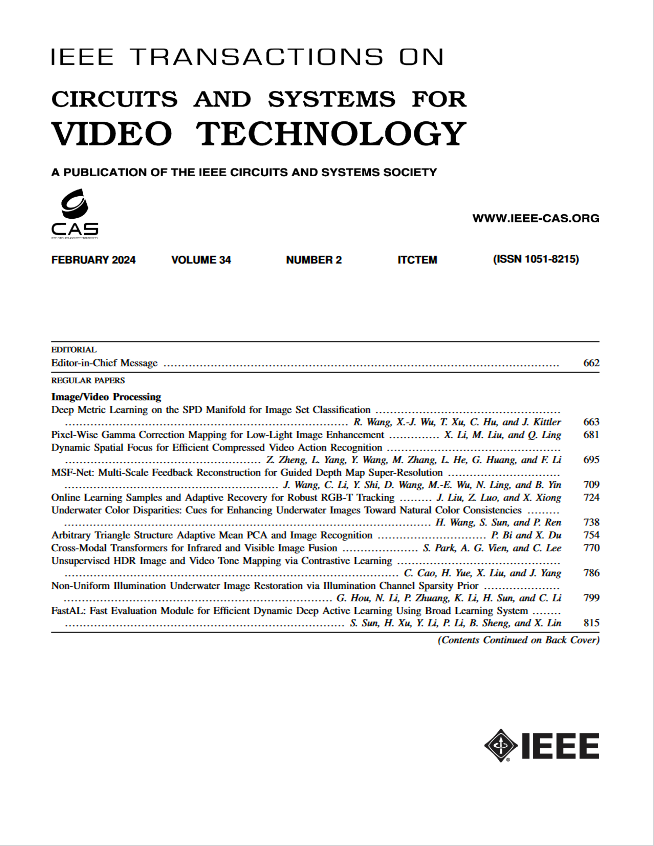CPAL: Cross-Prompting Adapter With LoRAs for RGB+X Semantic Segmentation
IF 11.1
1区 工程技术
Q1 ENGINEERING, ELECTRICAL & ELECTRONIC
IEEE Transactions on Circuits and Systems for Video Technology
Pub Date : 2025-01-29
DOI:10.1109/TCSVT.2025.3536086
引用次数: 0
Abstract
As sensor technology evolves, RGB+X systems combine traditional RGB cameras with another type of auxiliary sensor, which enhances perception capabilities and provides richer information for important tasks such as semantic segmentation. However, acquiring massive RGB+X data is difficult due to the need for specific acquisition equipment. Therefore, traditional RGB+X segmentation methods often perform pretraining on relatively abundant RGB data. However, these methods lack corresponding mechanisms to fully exploit the pretrained model, and the scope of the pretraining RGB dataset remains limited. Recent works have employed prompt learning to tap into the potential of pretrained foundation models, but these methods adopt a unidirectional prompting approach i.e., using X or RGB+X modality to prompt pretrained foundation models in RGB modality, neglecting the potential in non-RGB modalities. In this paper, we are dedicated to developing the potential of pretrained foundation models in both RGB and non-RGB modalities simultaneously, which is non-trivial due to the semantic gap between modalities. Specifically, we present the CPAL (Cross-prompting Adapter with LoRAs), a framework that features a novel bi-directional adapter to simultaneously fully exploit the complementarity and bridging the semantic gap between modalities. Additionally, CPAL introduces low-rank adaption (LoRA) to fine-tune the foundation model of each modal. With the support of these elements, we have successfully unleashed the potential of RGB foundation models in both RGB and non-RGB modalities simultaneously. Our method achieves state-of-the-art (SOTA) performance on five multi-modal benchmarks, including RGB+Depth, RGB+Thermal, RGB+Event, and a multi-modal video object segmentation benchmark, as well as four multi-modal salient object detection benchmarks. The code and results are available at:带有lora的RGB+X语义分割的交叉提示适配器
随着传感器技术的发展,RGB+X系统将传统的RGB相机与另一种辅助传感器相结合,增强了感知能力,并为语义分割等重要任务提供了更丰富的信息。然而,由于需要特定的采集设备,很难获取大量的RGB+X数据。因此,传统的RGB+X分割方法往往对相对丰富的RGB数据进行预训练。然而,这些方法缺乏相应的机制来充分利用预训练模型,并且预训练RGB数据集的范围仍然有限。最近的研究使用提示学习来挖掘预训练基础模型的潜力,但这些方法采用单向提示方法,即使用X或RGB+X模态来提示RGB模态的预训练基础模型,而忽略了非RGB模态的潜力。在本文中,我们致力于同时开发RGB和非RGB模式下预训练基础模型的潜力,由于模式之间的语义差距,这是非微不足道的。具体来说,我们提出了CPAL(带有LoRAs的交叉提示适配器),这是一个框架,其特点是一个新的双向适配器,可以同时充分利用互补性并弥合模式之间的语义差距。此外,CPAL引入了低秩自适应(LoRA)来微调每个模态的基础模型。在这些元素的支持下,我们成功地在RGB和非RGB模式中同时释放了RGB基础模型的潜力。我们的方法在五个多模态基准测试上实现了最先进的(SOTA)性能,包括RGB+Depth、RGB+Thermal、RGB+Event和一个多模态视频对象分割基准测试,以及四个多模态显著目标检测基准测试。代码和结果可在https://github.com/abelny56/CPAL上获得。
本文章由计算机程序翻译,如有差异,请以英文原文为准。
求助全文
约1分钟内获得全文
求助全文
来源期刊
CiteScore
13.80
自引率
27.40%
发文量
660
审稿时长
5 months
期刊介绍:
The IEEE Transactions on Circuits and Systems for Video Technology (TCSVT) is dedicated to covering all aspects of video technologies from a circuits and systems perspective. We encourage submissions of general, theoretical, and application-oriented papers related to image and video acquisition, representation, presentation, and display. Additionally, we welcome contributions in areas such as processing, filtering, and transforms; analysis and synthesis; learning and understanding; compression, transmission, communication, and networking; as well as storage, retrieval, indexing, and search. Furthermore, papers focusing on hardware and software design and implementation are highly valued. Join us in advancing the field of video technology through innovative research and insights.

 求助内容:
求助内容: 应助结果提醒方式:
应助结果提醒方式:


